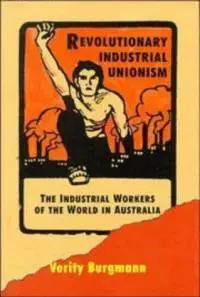 There are presently two anarcho-syndicalist projects in Australia, the ASF and the IWW.
There are presently two anarcho-syndicalist projects in Australia, the ASF and the IWW.
[Update, 17 July: In light of criticism put forward by a comrade in the discussion thread, I’ve changed my opinion on this description of the IWW. It is not accurate to describe the IWW as anarcho-syndicalist, even if it is significantly influenced by anarcho-syndicalism. I recommend Davo’s comments in the discussion thread.]
Both the ASF and the IWW claim to be unions, but at present neither of these two groups organise workplaces. They are small political groups advancing the concept of syndicalist unionism.
In a recent article, Socialist Alternative member Daniel Lopez argued that the IWW in Australia were not really Anarchist at all. He was writing about the 1910s IWW, the same argument could be made about the modern Australian claimant to the IWWs legacy.
The IWW denies that it is anarchist, it’s publications make use of Marxian economics (labour theory of value, surplus value, etc), and it consistently argues that the working class must liberate itself or not at all.
But the IWW is anarchist. Syndicalism is part of the anarchist tradition, it is an anarchist strategy. Syndicalist organisations utilize Marxian economic understandings because Anarchists critically appropriate Marx’s analysis of capitalism.
And Syndicalist organisations include Marxists, because when Anarchists attempt to build mass organisations, they do not make anarchism a pre-requisite for membership. Anarchists seek to draw in militants of all stripes who are in broad agreement with Anarchist aims[1].
Daniel Lopez advances several critiques of the 1910s IWW’s political practice:
It is important to account for why the IWW was wrecked … So long as capitalism is stable, unions of any size are going to accept industrial legality. Either this, or be de-registered and wrecked, as with the Builders Labourers Federation.
…
Organising a separate, radical union in opposition to the mainstream ones is a mistaken tactic 95 percent of the time.
…
Rather than take the fight to the bureaucrats, constantly organising within the unions against them, it leaves them unchallenged within their own organisations, and has the effect of separating the best militants.
…
they didn’t have a perspective for building a party. Such a perspective can anticipate and cope with periods of illegality.
(Ben D* of the IWW’s Melbourrne GMB responded here[2]).
[Update, 17 July: Daniel Lopez has in turn responded to Ben D*’s article here. It’s worth reading.]
[Update, 22 July: Another response from an IWW comrade here.
The decision to deny or announce a syndicalist organisations commitment to Anarchist practice is a tactical one, and in part it ties into that critique of the IWW that Lopez highlights.
In Australia, the ASF announces it’s anarchism. Like the IWW, identity as an anarchist is not a prerequisite for membership:
Being a member of the ASF does not require you to be an anarchist but to simply agree to work within the Aims Principles and Statutes upon which we organise.
But the fact that their name is the “Anarcho-Syndicalist Federation” has much the same effect, deterring non-Anarchists from participation. In the fight against reformism, this has it’s advantages, but it hampers the task of building the kind of mass organisation that syndicalist strategy requires.
From it’s beginnings, the IWW has sought to unite workers of diverse levels of politics, strategically denying it’s anarchist connection helps achieve this. But an organisation that is less explicit in its politics faces a greater challenge in ensuring that it remains revolutionary and does not descend into reformism.
As an ASF comrade pointed out to me recently, these are old debates. But they are still debates that Australian Anarchists have yet to resolve.
Almost all organised class-struggle Anarchists in Australia are involved in either the IWW or the ASF. Whether they are drawn to one or the other seems to depend on where they stand on the tactical question of explicitly anarchist syndicalist organising, or implicitly anarchist syndicalist organising.
They are both tiny groups, neither organise workplaces at this point in time, they are only at the stage of advancing the idea of syndicalist union, yet the effects of this decision are still apparent. The political education of IWW members is lower[3], the ASF’s members have clearer politics, but fail to make the recruiting gains of the IWW[4].
Is Syndicialism the wrong strategy? Socialist Alternative would say so, but they only concieve of Syndicalism as anarchist attempts to build new unions from scratch. Whilst this has been the focus on Anarcho-Syndicalists in Australia, it is not the be all and end all of Syndicalist strategy.
Syndicalism is a radically democratic model for union organising that can be advanced within existing unions, in new unions, or through grassroots solidarity movements that cut across the union movement. The challenge faced by anarchists is not to build new syndicalist organisations, but rather to advance anarchist ideas (and thus syndicalist practice) throughout the labour movement. The decision as to whether to focus on critically engaging with existing unions, or building grass roots solidarity organisations, or to build new unions, should not be made a general principle. It’s a decision to make depending on the present circumstances in particular industries.
This flexibility of approach cannot be undertaken by an organisation that sets itself up as a syndicalist union in competition with the trade union movement. Be it the ASF or the IWW, these organisations are effectively locked into one strategy in all situations.
The alternative for organised Anarchists is to create specifically Anarchist organisations, that bring together committed militants, seek to understand the situation in various industries or political situations, and then advance anarchist ideas using the strategy that best suits the conditions encountered[5]. An effective syndicalist strategy requires organised Anarchist groups.
The gut reaction of many Anarchists is to condemn this as vanguardism.
In his response to Daniel Lopez’s article on the IWW, Ben D* of the IWW’s Melbourne GMB is quick to highlight Stalin, Red Terror and Totolitarianism. As Ben says, Anarchists seek to build organisations that “[maintain] a basic harmony between mean and ends”, an authoritarian party that seeks to lead the workers delivers a dictatorship, whereas the decentralised organisation of the entire working class makes dictatorship impossible.
Critics of specific, united and organised anarchist groups argue that they would function as Lenninist parties, and thus contain the same seeds of dictatorship. But there is a fundamental difference. An organisation of anarchist militants would not seek to make “the revolution”, “lead the working class” or establish a dictatorship of the party.
An organisation of Anarchist militants would seek to build mass popular organisations along syndicalist lines, and advance anarchist ideas in these organisations. If true mass organisations on Syndicalist lines can be built, an organised minoritty of any stripe would be unable to establish control, they could only seek to exert influence. Organised Anarchists seek to develop such organisations to the point that the popular power they embody can topple capitalism. It is through syndicalist organisation that Anarchists seek to topple capitalism.
There is a danger of dictatorship when a single organisation seeks to monopolise power, take leadership in the name of the working class, claim a monopoly on the right ideas and centralise popular power into a single party.
Which brings me back to Daniel Lopez’s recent article on the IWW.
Lopez’s article shows a great respect for the IWW of the 1910s, for a reason. Socialist Alternative seek to appropriate the legacy of the IWW for their version of Marxism.
Lopez’s critique of the IWWs practice is not unique to Marxist observers. Syndicalist practice in Australia to date has been limited. Syndicalism it is a powerful and radically democratic method of Anarchist organising, but without specifically anarchist organisations, it is an incomplete strategy.
[1].Black Flame Chapter V: Anarchism, Syndicalism, the IWW and Labour, for more.
[2]. I must confess, I can’t really work out what Ben D is getting at, beyond a general assertion that Vanguardist organising is a recipe for dictatorship and Syndicalism, despite it’s organisational faults, is not.
[3]. I will be eaten alive for saying this! I am not a member of either the ASF or the IWW, I make this judgement on the basis of observing IWW and ASF groups on FB. Hardly scientific!
[4]. Of course both are tiny, microscopic compared to the union movement they seek to reshape (from little things…), but the IWW is several times larger than the ASF.
[5]. FARJ, Social Anarchism and Organisation.
* Name sanitised at comrades request – 18-July-2012
 This line was enunciated in detail by
This line was enunciated in detail by  There are presently two anarcho-syndicalist projects in Australia, the ASF and the
There are presently two anarcho-syndicalist projects in Australia, the ASF and the